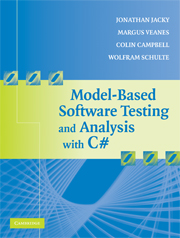17 - Further Reading
Published online by Cambridge University Press: 02 March 2010
Summary
There is a lot of research that has been done in the areas discussed in this part of the book. We mention some works that are related to the topics under discussion, and from which further related work can be found. The selection is far from exhaustive. The discussion follows the structure of this part of the book.
Compositional modeling. Protocol design and the layering principle mentioned in Section 14.1 are discussed in-depth in Comer (2000). The notion of features and the topic of feature interaction have been focused on telecommunication software. There is a series of books (see, e.g., Reiff-Marganiec and Ryan, 2005) that discuss approaches to alleviate the problem in that context. The sample protocol SP used in Section 14.2, although abstract, is related to real-life application-level network protocols such as the ones discussed in Hertel (2003).
Properties of model program composition that are discussed in Section 14.3 are analyzed formally in Veanes et al. (2007a), where composition, as treated in this book, is called parallel composition. The composition of model programs is effectively a program transformation that is most interesting when it is formally grounded in an existing semantics and has useful algebraic properties. The semantics of executing an action in a state with a rich background is founded on abstract state machines or ASMs (Gurevich, 1995; Blass and Gurevich, 2000). Determining the action traces that are produced and the properties of traces that are preserved when model programs are composed is founded on the view of model programs as labeled transition systems or LTSs (Keller, 1976; Lynch and Tuttle, 1987).
- Type
- Chapter
- Information
- Model-Based Software Testing and Analysis with C# , pp. 275 - 278Publisher: Cambridge University PressPrint publication year: 2007

